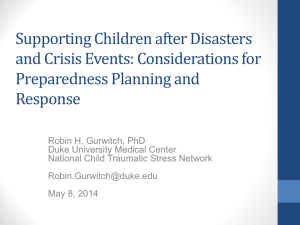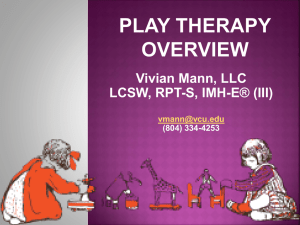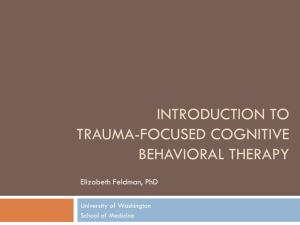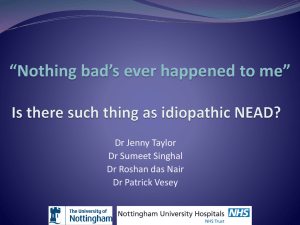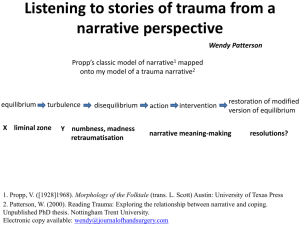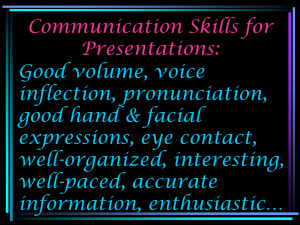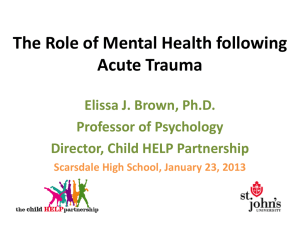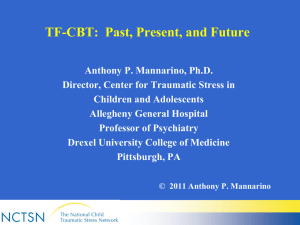here - Australian Psychological Society
advertisement
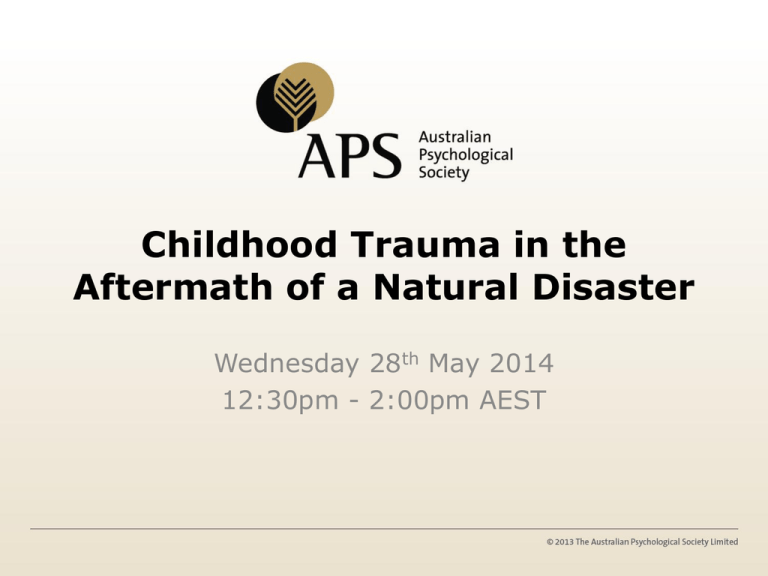
Childhood Trauma in the Aftermath of a Natural Disaster Wednesday 28th May 2014 12:30pm - 2:00pm AEST Before we start… • Ensure sound is on and volume turned up on your computer. • If you are experiencing problems with sound, dial in using your telephone as per details on your confirmation email (enter telephone number and password provided). • Dial 1800 733 416 for technical support (Redback). • Specific question/s may be asked throughout the webinar using the chat box - presenters will endeavour to answer them at the end of the webinar. PRESENTERS: Dr Susie Burke Psychologist Australian Psychological Society Dr Rowena Conroy Clinical psychologist Royal Children’s Hospital Facilitator: Jan-Louise Godfrey, APS Childhood trauma in the aftermath of a natural disaster Susie Burke APS Agenda • Introduction Recent disasters in Australia • Perth Fires 2014 – • Blue Mountain Fires Oct 2013 – – • 35 died, 70 towns 200,000 people affected Victorian floods 2010 83 towns • • 1 died, 150 homes, + 650 uninhabitable, 2000 + damaged QLD Floods – – – • 100 properties destroyed Cyclone Yasi – – • 248 homes destroyed 2 died Dunalley (TAS) Fires Jan 2012 – • 50 homes destroyed Black Saturday Fires 2009 – – 173 died 2000 homes destroyed Current and future threats • Climate change is expected to underpin a steady increase in climate related disasters • Worldwide, children have the greatest risk of harm from climate change impacts • Our health system is under-prepared for increased weatherrelated disaster service demand Children in disasters • “whilst it is extremely common for children to experience some symptoms of traumatic stress after a natural disaster, most do not experience a serious mental health syndrome” • • • • • • • • • • Children’s responses are different to adult responses Reactions will be different for each individual There is no ‘one way’ to respond Responses range from mild stress reactions to more serious responses Resilience is the norm Most recover well with the support of family and friends The path of recovery is not smooth Setbacks are part of normal recovery Children’s needs often go up over time A minority (10-20%) of survivors are at risk of developing significant mental health problems Children’s reactions by age Behavioural signs 0 to 5 years Clinginess and separation difficulties Easily frightened Changes to eating & sleeping patterns Regressions Crying easily Searching for the person or thing that has been lost as a result of the traumatic event Need for routine, consistency and familiarity Struggling to communicate in words 0 to 5 years Common feelings Confusion and uncertainty Challenges to ‘basic trust’ Being confused or frightened by intense feelings and reactions Sensitive to trigger reminders and changes in mood of primary caregivers Long-lasting perceptual memories 5-12 years Behavioural signs Difficulty concentrating, vagueness or acting ‘hyper’ Poor relationships at home or school, or poor performance at school Preoccupation with other traumatic events or disasters Lack of interest in new activities Persistent sleep disturbances or nightmares Reenactments Personality changes Regressions 5 to 12 years Common thoughts and feelings: Fear of recurrence Distress at reminders Concern about personal responsibility Mood or personality changes Increased self focusing or withdrawal Lowered self esteem Wish for revenge How to help children? 3 tiered framework • Level 1 - Simple practical, emotional & informational support • Level 2 – Simple psychological strategies • Level 3 – Formal mental health interventions 3 - Formal mental health interventions 2 - Simple psychological strategies 1 - Simple practical, emotional & informational support Stepped care for children Evidence-based Must include families Starting with least intrusive, population level Ending with clinical consultation if needed Level 1 type Continuity of schooling Activities for recovery Creativity (play, art) Books, workbooks Psycho-education – (e.g., information for parents re helping children feel safe) Classroom programs Resilience building Level 2 type Skills for Psychological recovery Level 3 Psychological therapies Five Empirically-Supported Early Intervention Principles Australian Centre for Post Traumatic Mental Health (ACPMH) Hope SelfEfficacy Safety Calming Connectedness What is psychological first aid • Human, caring, compassionate response • Basic common sense principles of support • DO NO HARM • Evidence informed • Focus on: – Practical needs – Basic comfort – Connection to necessary supports PFA for children • • ‘PFA is probably the most immediate and useful method of assisting children and young people whether it is directly or via caregiver’. (Ursano et al., 2007) LISTEN with your ears and eyes don’t force talking ask questions like: • what do you think has happened? • what are you most worried about? PROTECT – keep the child safe, be patient, try and keep routines, monitor media exposure CONNECT – reach out to family, friends, community resources etc. (UCLA Centre for Public Health & Disasters) Supporting children aged 0 to 5 Maintain routines Reassure them that they are safe Keep a calm atmosphere in children’s presence Avoid unnecessarily separating children from their important caregivers Tolerate children’s clinginess and lack of independence Listen to children’s retelling of events Respect children’s fears and give them time to cope Protect children from reexposure Accept and help children to name strong feelings during brief conversations Expect uncharacteristic behaviour but maintain basic rules Ruth Wraith Supporting children aged 5 to 12 Listen to what children say, think and feel Correct any misperceptions about the disaster, help them to understand what has happened Keep to normal routines Protect children from re-exposure, monitor amount of media exposure Ask you child what you could do to help them Watch how they play, monitor how they are coping at school and in community activities Expect uncharacteristic behaviour but maintain basic rules Remain aware of your own reactions to children’s distress Provide opportunities for children to experience control Encourage children to explore ways of helping others Discuss your feelings openly and honestly and explain how you feel Use creative outlets Treating moderate distress • Some children will experience ongoing reactions that will cause enough distress to interfere with adaptive coping. • These children do NOT have severe mental health problems • These children do NOT have long-term difficulties in recovery • Research suggests that a skills building approach is more effective than supportive counseling Skills for Psychological Recovery Developed in US post Hurricane Katrina Adapted for Australian use in 2009 Model for facilitating recovery following disasters For anyone effected by disaster Designed to reduce distress, regain control, increase self-efficacy, accelerate recovery In weeks and months, after PFA Practical, skills-building approach Does not assume pathology Components of SPR • gathering information & prioritising assistance • building problem-solving skills • promoting positive activities • managing reactions • promoting helpful thinking • rebuilding healthy social connections Problem-Solving Disasters often result in many practical problems Problem-solving helps the child to manage the problem actively and move on; improves feelings of control and self efficacy (Considered most useful of all SPR skills) Steps what is the problem? (how often, who is involved, how do you feel, rank, decide ownership) What do you need, want? Brainstorm (go for at least 10!) Choose best options (rate each option) Managing Emotional Reactions “when something bad has happened there are lots of ways that you might be reminded of it afterwards. Eg… Your reactions to these reminders can get in the way of what you are doing at home, at school, or when you are with your friends. It is really good to learn some skills that can help you deal with these reactions so that they don’t get in your way. Each time you practice them you will find that you get a little better at it. Also, you learn that you have more control than you think”. Toolkit: Identifying body reactions Calming skills Breathing exercise Self talk Social support Naming feelings and concerns to better understand and to communicate with others Helpful Thinking Disasters can change the way we think about ourselves and our world Distressing disasterrelated thoughts can maintain negative emotions (fear, anger) Focus on helpful thoughts improves mood and paves way for more effective coping Children rely heavily on caregivers/adults in their environment when forming thoughts Work with caregivers to identify their unhelpful thoughts as well • Games and activities to discuss thoughts: • Go fish • Good coach, bad coach Social connections • Children maintain social connection through play • Often after a disaster children may slow down, disengage from play, mimic the ‘energy and posture’ of their caregivers (slowed down, slumped, depressed) • Adults need to remember how helpful play is • Caregivers can practice giving permission for children to play • Caregivers can help to organise plays for children Positive activities “Since the disaster you may have felt like you were filled up with a lot of icky feelings. Now, I can’t just make those feelings go away! I wish it were that easy! What we can do is work on filling up some of your time with activities that will fill you with positive, happy feelings” (From ACPMH 2009, SPR manual, 2009) Psychological assessment and intervention with children and adolescents after natural disasters APS Webinar, May 28th 2014 Rowena Conroy M.Psychol(Clin.), PhD, MAPS (CCLlN) The Royal Children’s Hospital, Melbourne The University of Melbourne Murdoch Children’s Research Institute Recovery Trajectories • Initial distress for most • Most recover without formal mental health intervention • A significant minority have ongoing difficulties; course can be chronic if untreated Common psychological difficulties Affective: fear; worry; irritability; sadness; anger; guilt Cognitive: concentration; intrusions; nightmares; thoughts (about event/symptoms/self/world/future) Behavioural: avoidance; school refusal; substance use; self-harm; suicidal behaviours; vigilance; safety-seeking; regression; tantrums; aggression; non-compliance Physical: stomach aches; headaches; sleep; “jumpiness” Functional Impairments: academic; social; physical Developmental considerations Where there is a history of Type II Trauma (“Complex Trauma”) • Dysregulation (affective, behavioural, cognitive) – – – – Emotional reactivity Numbing Dissociation Self-harm • Attachment difficulties – Other relationship difficulties – Prominent shame – (Sexual behaviour) Mental Health Disorders • Post-traumatic Stress Disorder (PTSD) • Other Anxiety Disorders • Depression • Oppositional Defiant Disorder (ODD) • Attention Deficit Hyperactivity Disorder (ADHD) • Substance Abuse (Adolescents) Risk Factors: Event-related • Proximity/Exposure • Subjective fear/Perceived life threat • Pain • Separation from parents • Interpersonal • Repeated • Subsequent stressors Risk Factors: Individual • Prior trauma exposure • Prior emotional/behavioural difficulties • Female gender (for “internalising” presentations) • Post-event avoidance, rumination Risk Factors: Family/Other Systems • Parent mental health • Parental trauma history • Family functioning difficulties • Low social support Assessment Considerations • Always assess for trauma exposure • Consider multiple outcomes • Multiple informants • Developmental considerations • Hallmark avoidance Assessment Considerations, cont. • Assessment of current coping strategies • Consider standardised measures • Assess functioning of family system (& other systems) • Risk assessment • Assessment is ongoing Australian Centre for Posttraumatic Mental Health (ACPMH; 2013) www.acpmh.unimelb.edu.au/resources American Academy of Child & Adolescent Psychiatry (AACAP; 2010) www.aacap.org National Institute for Clinical Excellence (NICE; 2005) (UK) www.nice.org.uk Intervention for PTSD • Trauma-Focussed Cognitive Behaviour Therapy (TF-CBT): – Strongest empirical support – Endorsed by national “best-practice” guidelines • Substantial reductions in severity of PTSD symptoms after: – Natural disasters – Terrorist attacks – Motor vehicle accidents – Witnessed violence – Sexual & nonsexual assaults – Sexual abuse Trauma-Focussed CBT: Components Psychoeducation Parenting Relaxation Affective expression & modulation Cognitive coping Trauma narrative (imaginal exposure) • In vivo exposure • Conjoint parent-child sessions • Enhancing safety and future development • • • • • • Cohen, J. A., Mannarino, A. P. & Deblinger, E. (2006). Treating trauma and traumatic grief in children & adolescents. New York: Guilford Press. Cohen, J. A., Mannarino, A. P., & Deblinger, E. (2012). Trauma-focused CBT for children and adolescents: Treatment applications. New York: Guilford Press. Psychoeducation • Enhancing understanding of – – – – Reactions Triggers Role of coping strategies Role of family • Normalises reactions • Opportunity to correct misconceptions • Engendering hope Affect Labelling/Modulation • Immediate symptom relief • Replacing less adaptive coping strategies • Groundwork for other therapy components • May need plenty of attention if history of repeated trauma Cognitive Therapy • Addressing cognitions that are causing distress/impairment – – – – “Our house will burn down again” “Nowhere is safe anymore” “I’m never going to be happy again” “If I hadn’t gone back to get my bag, our house would have been ok” Exposure (Graded, Prolonged) • May be indicated when intrusive trauma-related symptomatology is prominent • Exposure to memories (trauma narrative) (imaginal) • Exposure related to situations (in vivo) • Going outside when it’s hot(/stormy/windy/raining/….) • Going to barbeques • Sleeping in own bed • With care, consent, and appropriate clinician training Caregiver Involvement • Consider barriers and strengths • Parenting behaviour as the target • Parents as “coaches” • Referrals for caregivers “Process” considerations • Formulation-driven intervention • Hallmark avoidance (can be subtle) • Consider longer sessions (habituation/arousal reduction) • Developmentally-appropriate adaptations “Process”, cont. • Home-based tasks • Rewards • Impact of heightened arousal on therapy • Control TF-CBT & Complex PTSD • Modifications may be needed when Type II trauma history present – – – – – – Attachment and the therapeutic relationship Initial engagement & stabilisation Affect regulation/distress tolerance Pace Length Crisis management “derailing” TF-CBT Resources • National Child Traumatic Stress Network (USA) www.nctsnet.org • Australian Child & Adolescent Trauma, Loss & Grief Network (ACATLGN) www.earlytraumagrief.anu.edu.au • Australian Centre for Posttraumatic Mental Health www.acpmh.unimelb.edu.au • National Center for PTSD (USA) www.ncptsd.va.gov • Australian Psychological Society www.psychology.org.au/topics/disasters/bushfires • International Society for Traumatic Stress Studies www.istss.org Resources, cont. • Tulane Institute of Infant and Early Childhood Mental Health www.infantinstitute.org • Australian Centre for Grief and Bereavement www.grief.org.au • Psychosocial Support in Disasters www.psid.org.au • Children and War Foundation www.childrenandwar.org • Online TF-CBT training http://tfcbt.musc.edu QUESTIONS & ANSWERS REMINDERS • Contact The ATAPS CMHS Clinical Support Service. Phone 1800 031 185 or email clinicalsupport@psychology.org.au • One more webinar on the treatment of attachment disorders in June – See the ATAPS Clinical Support Service web portal for details. • A recording of this webinar will be available on the APS ATAPS Clinical Support Service web portal - see http://www.psychology.org.au/ATAPS/networking_CMHS/ • Please complete the Exit Survey – your feedback is appreciated! • Thank-you for your participation and we hope you enjoyed it.
